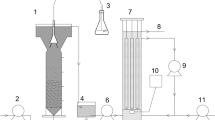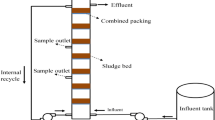Abstract
The creation of anoxic granulated biomass has been monitored in a laboratory USB (Upflow Sludge Blanket) reactor with the volume of 3.6 L. The objective of this research was to verify the possibilities of post-denitrification of residual NO3-N concentrations in treated wastewater (denitrification of 10-20 mg L−1 NO3-N) and to determine the maximum hydraulic and mass loading of the granulated biomass reactor. G-phase from biodiesel production and methanol were both tested as external organic denitrification substrates. The ratio of the organic substrate COD to NO3-N was 6. Only methanol was proven as a suitable organic substrate for this kind of reactor. However, the biomass adaptation to the substrate took over a week. The cultivation of anoxic granulated biomass was reached at hydraulic loading of over 0.35 m h−1. The size of granules was smaller when compared with results found and described in literary reports (granules up to 1 mm); however, settling properties were excellent and denitrification was deemed suitable for the USB reactor. Sludge volume indexes of granules ranged from 35-50 mL g−1 and settling rates reached 11 m h−1. Maximum hydraulic and mass loadings in the USB reactor were 0.95 m3 m−2 h−1 and 6.6 kg m−3 d−1. At higher loading levels, a wash-out of the biomass occurred.
Similar content being viewed by others
References
Bhatti, Z. I., Sumida, K., Rouse, J. D., & Furukawa, K. (2001). Characterization of denitrifying granular sludge treating soft groundwater in USB reactor. Journal of Bioscience and Bioengineering, 91, 373–377. DOI: 10.1016/S1389-1723(01)80154-7.
Borzacconi, L., Ottonello, G., Castelló, E., Pelaez, H., & Gazzola, A. (2000). Denitrification in carbon and nitrogen removal system for leachate treatment. Water Science and Technology, 40, 145–151. DOI: 10.1016/S0273-1223(99)00620-4.
Cuervo-López, F.M., Martinez, F., Gutiérrez Rojas, M., Noyola, R. A., & Gómez, J. (1999). Effect of nitrogen loading rates and carbon sources on denitrification and sludge settleability in UASB reactor. Water Science and Technology, 40, 123–130. DOI: 10.1016/S0273-1223(99)00617-4.
Eiroa, M., Kennes, C., & Veigga, M. C. (2004). Formaldehyde and urea removal in denitrifying granular sludge blanket reactor. Water Research, 38, 3495–3502. DOI: 10.1016/j.watres.2004.04.055.
Franco, A., Roca, E., & Lema, J. M. (2006). Granulation in high-load denitrifying USB pulsed reactor. Water Research, 40, 871–880. DOI: 10.1016/j.watres.2005.11.044.
Green, M., Tarre, S., Shnizer, M., Bogdan, B., Armon, R., & Shelet, R. (1994). Groundwater denitrification using an upflow sludge blanket reactor. Water Research, 28, 631–636. DOI: 10.1016/0043-1354(94)90013-2.
Jenicek, P., Zabranska, J., & Dohanyos, M. (2002). Adaptation of methanogenic granules to denitrification in anaerobic-anoxic USB reactor. Water Science and Technology, 45, 335–340.
Kratochvíl, K., Drtil, M., Derco, J., & Bilanin, M. (1996a). Comparison of ethanol and glucose in denitrification of drinking water in USB reactor. Vodohospodársky spravodajca, 39, 15–17. (in Slovak)
Kratochvíl, K., Drtil, M., Hutňan, M., Derco, J., & Fargašová, A. (1996b). Denitrification of drinking water in USB reactor. Vodohospodársky spravodajca, 39, 9–13. (in Slovak)
Kratochvíl, K., Drtil, M., Hutňan, M., Derco, J., & Fargašová, A. (1997). Characteristic of granulated denitrification biomass. Vodní hospodářství, 47, 23–26. (in Slovak)
Lettinga, G., & Hulshoff Pol, L. (1986). Advanced reactor design, operation and economy. Water Science and Technology, 18, 99–108.
Lettinga, G., van Velsen, A. F. M., Hobma, S.W., de Zeeuw, W., & Klapwijk, A. (1980). Use of the upflow sludge blanket reactor concept for biological wastewater treatment, especially for anaerobic treatment. Biotechnology and Bioengineering, 22, 699–734. DOI: 10.1002/bit.260220402.
Ruiz, G., Jeison, D., & Chamy, R. (2006). Development of denitrifying and methanogenic activities in USB reactors for treatment of wastewater: Effect of COD/N ratio. Process Biochemistry, 41, 1338–1342. DOI: 10.1016/j.procbio.2006.01.007.
Van der Hoek, J. P., & Klapwijk, A. (1987). Nitrate removal from ground water. Water Research, 21, 989–997. DOI: 10.1016/S0043-1354(87)80018-0.
Author information
Authors and Affiliations
Corresponding author
Rights and permissions
About this article
Cite this article
Pagáčová, P., Drtil, M. & Galbová, K. Granulation of activated sludge in a laboratory upflow sludge blanket reactor. Chem. Pap. 63, 125–130 (2009). https://doi.org/10.2478/s11696-008-0092-1
Received:
Revised:
Accepted:
Published:
Issue Date:
DOI: https://doi.org/10.2478/s11696-008-0092-1




